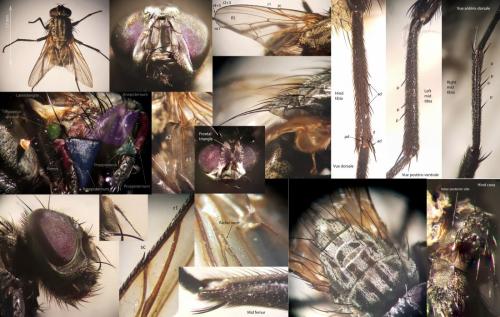Thread subject: Diptera.info :: Hydrotaea meridionalis?
Posted by Widus on 07-09-2020 16:27
#1
Hi,
Could this be the species mentioned in the title of the subject?

Christian Widmann : Suisse : Lausanne : 1010 : 07/06/2020
Altitude : 632 m - Taille : 7.7 mm (corps)
Réf. : 259924
Click on the image to enlarge it.
Posted by Nikita Vikhrev on 09-09-2020 15:52
#2
With this mosaic of tiny images I can only say:
Muscidae
not Hydrotaea
Please, large dorsal and lateral views, one by one
Posted by Widus on 15-09-2020 16:26
#3
Dear Nikita,
Thank you for taking a look at those images. If you click on the composite image, it should get much bigger and details can hopefully be seen better.
Anyways, I will upload more images as requested.
Regards,
Christian
Posted by Nikita Vikhrev on 15-09-2020 19:25
#4
I tried to click, no result.
I can see that radial node setulose. Is it ventral side only or both sides?
Posted by Widus on 15-09-2020 20:01
#5
Radial node setulose on both sides
Try this
link for larger images.
Also two additional images added.
Edited by Widus on 15-09-2020 20:41
Posted by Widus on 15-09-2020 20:39
#6
Side view
Posted by Nikita Vikhrev on 16-09-2020 10:16
#7
"Radial node setulose on both sides"
Thus,
Mydaea and you have the following choise
Posted by Widus on 19-09-2020 15:34
#8
Arista plumose, longest aristal hairs about width of flagellomere
-> not
Mydaea anicula
-> not
Mydaea obscurella
Edited by Widus on 19-09-2020 15:58
Posted by Widus on 19-09-2020 15:50
#9
Prealar < posterior notopleural
Fore femur without posterior seta
-> not
Mydaea nebulosa
Edited by Widus on 19-09-2020 15:55
Posted by Widus on 19-09-2020 16:07
#10
I can also discard
Mydaea nubila which is shorter than 7.7 mm and which also has darkened halteres
So it seems it is
Mydaea ancilla. The mediotergite indeed appears shiny black and not pruinose (although I could not take a convincing pictures of this structure on my specimen as the wings were hiding it). Supporting criteria include:
- scutum with 4 very dark stripes
- posterior crossvein oblique
- prealar seta about 3/4 of posterior notopleural, although here pra is 85-91% of post nt (based on two measurements from different images)
- katepisternals 1 + 2
- fore tibia without posterior seta
- hind tibia with 2-3 anterodorsals and 2-3 anteroventrals
Edited by Widus on 20-09-2020 11:53
